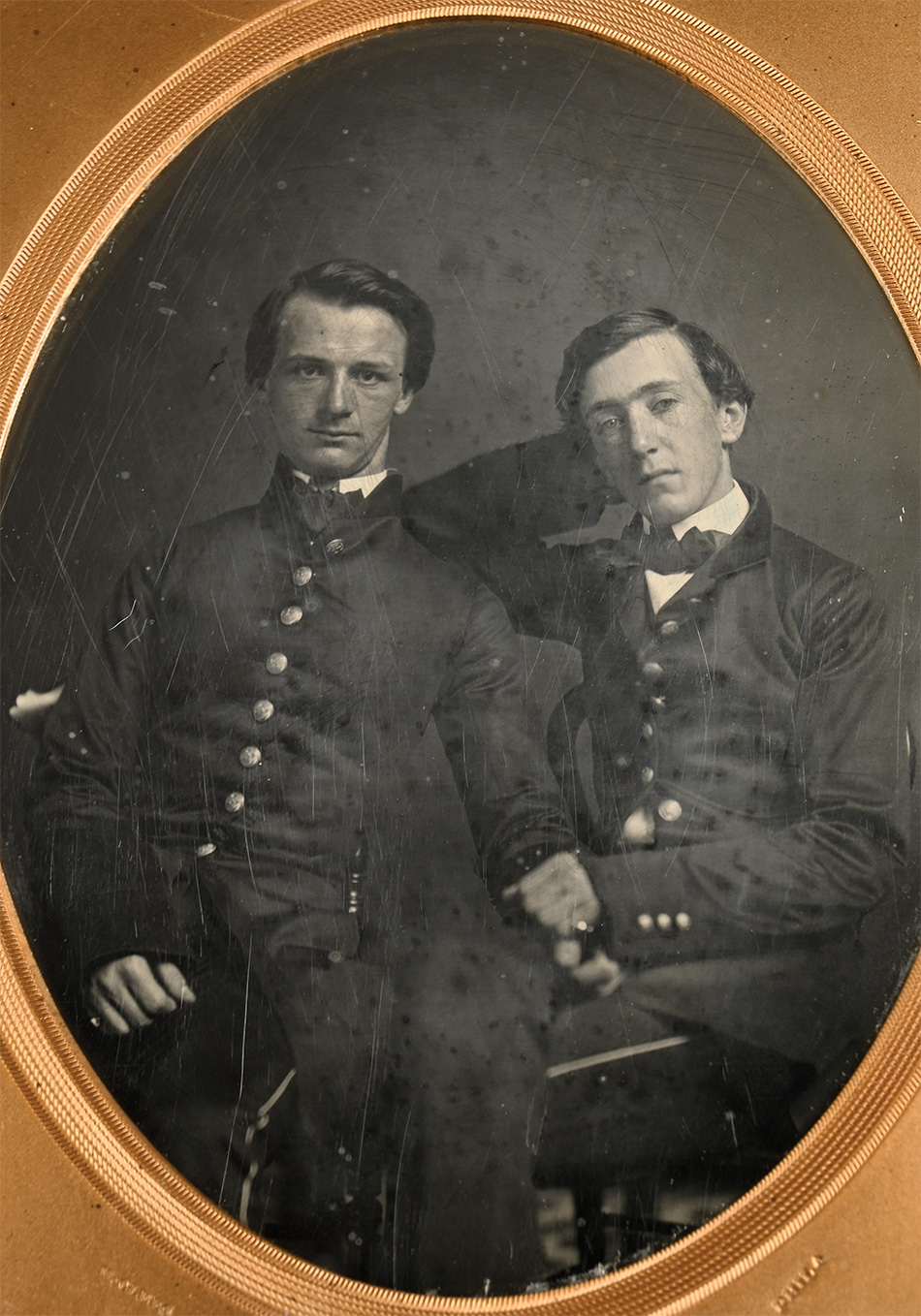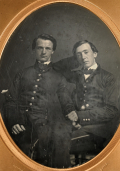site search
online catalog
HALF-PLATE DAGUERREOTYPE OF C.S. MAJOR GENERAL STEPHEN DODSON RAMSEUR AND C.S. COLONEL FRANK KINCLOCH HUGER AS WEST POINT CADETS BY JAMES EARLE McCLEES, PHILADELPHIA

$30,000.00
Quantity Available: 1
Item Code: 1138-1780
This important half-plate daguerreotype comes from the collection of the late Bill Turner and shows future Confederate Major General Stephen Ramseur on the left and future Confederate artillery Colonel Frank Huger, son of CS General Benjamin Huger on the right. Vignette versions of the photo were used for engravings of Ramseur and at least one portrait with a Confederate uniform added. The full engraving with both Ramseur and Huger identified was published by Gallagher in his 1985 article on Ramseur at West Point in NCHR and in his book on Ramseur.
Ramseur sits upright, looking squarely at the camera, apparently open and earnest. Huger poses casually, almost languidly, turning slightly toward Ramseur and resting his bent elbow on the back of Ramseur’s chair, supporting his head with his hand, and resting his other hand across Ramseur’s. Both wear dark blue frock coats with brass buttons on the front and cuffs, but no insignia, and dark trousers with a narrow stripe. The image is sometimes dated to 1860, the time of their graduation, but could date to June 1857 when Ramseur began a ten-week leave or to July 1859, when he started a month-long leave, during which he attended his sister’s wedding. Cadets were authorized a plain blue officer’s frock coat without insignia for wear on leave (and even a special “furlough cap.” The buttons seem less convex than standard eagle buttons and are likely the low–convex “CADET/USMA” pattern. (See Todd for details on the furlough uniform.)
Ramseur is one of the most romanticized southern generals, eulogized for his religious faith and bravery, regarded by many as the embodiment of contemporary ideals of manliness, godliness, honor, duty, and even knightliness. On the battlefield he also had a reputation for aggressiveness that verged into rashness. All this was combined with a certain aristocratic hauteur, despising slave trading not on moral grounds, he thought slavery “blessing,” but for its crass preoccupation with money. This in spite of his family’s mercantile background and a business set-back for his father that got him thinking about career options. Nevertheless, he was a true believer, despising Yankees and abolitionists, a fervent secessionist, at the Academy he preferring the company of fellow southerners, and advising his sister to do the same. Even after the election of Buchanan, he believed “disunion” had to come “at whatever cost.”
Born in and appointed from North Carolina to West Point, his military abilities were greater than his academic talents, but he rose to be a captain in the cadet battalion and graduated 14th in his class, with Huger as 31st, perhaps accounting for some of the body language in the image. As brevet 2nd Lieutenant he was posted to the artillery at Fort Monroe, but never took up his post with the 4th U.S. Artillery after his commission as full 2nd lieutenant in February 1861, instead seeking a commission from the newly formed Confederate government, well before his own state’s secession. He formally resigned April 6, took a commission as a C.S. 1st lieutenant to date April 22, but was made captain of the North Carolina Ellis Light Artillery very soon after and by late May was lieutenant colonel of the 3rd North Carolina. He was sidelined for almost a year with a broken collar bone suffered in a fall from a horse, but returned to command the 49th NC as colonel in the Peninsula Campaign and was praised by Lee for his conduct in the futile assault at Malvern Hill, which cost him a disabled right arm. He returned to a command a brigade in Jackson’s Corps after Antietam, with promotion to brigadier general as of November 1, 1862. His brigade was in the forefront of Jackson’s flank attack at Chancellorsville in May 1863 and his aggressiveness was again noted by superior officers, Lee writing that Jackson himself had praised Ramseur’s conduct. At Gettysburg he was given command of the shattered brigades of Iverson and O’Neill to use with his own, and he played a significant part in the collapse of the Union right on July 1 by striking the right and rear of Union forces along Oak Ridge, and later billing the government for a horse killed under him in the fighting.
In May 1864 he drove back Burnside at the end the Wilderness and counterattacked Union troops in slaughter of Spotsylvania, where he was wounded again in the arm. In June he was promoted to Major General at age 27, given command of Early’s division, and fought at Cold Harbor before following Early into the Shenandoah. His aggressiveness at Stephenson’s Depot, resulted in a defeat, but he remained in Early’s good graces and at Cedar Creek in October he rallied a portion of his division to hold off Sheridan’s counterattack for more than an hour, losing two more horses and suffering another wound, before being mortally wounded while mounting a third. Captured by some of Custer’s troopers, he died at Belle Grove Plantation, Sheridan’s headquarters, the next day, visited by old acquaintances from West Point, who arranged for his body to be embalmed and sent through the lines. His story was rendered even more poignant by having received word of the birth of his first child just two days before the battle, and inspirational by his professions of religious faith and devotion to his wife in his last moments. North Carolina erected a monument to him at Belle Grove Plantation in 1919.
Frank Huger (1837-1897) was born in Virginia, the son of later CS General Benjamin Huger. An “at large” appointment, entered West Point in 1855 with Ramseur and graduated with him in 1860. Appointed brevet 2nd lieutenant in the 3rd US Infantry 1 July 1860 and 2nd lieutenant in the 10th on 19 January 1861, he submitted his resignation on May 21, a month after Virginia seceded and several months after Ramseur’s resignation. He was appointed a captain of artillery and commanded the Norfolk Light Artillery, which served in his father’s division in the Seven Days Battles in front of Richmond. He saw further action at Second Bull Run and Fredericksburg, was promoted major in March 1863, and commanded C.S. artillery on the high ground at Hazel Grove at Chancellorsville on May 3, moving to fight the next day at Salem Church. At Gettysburg he fought in support of Longstreet’s attack on the Union left on July 2. In the Fall he went west with Longstreet, taking over command of E.P. Alexander’s artillery battalion and being promoted to lieutenant colonel in February 1864. He served against Grant in the Overland Campaign and at Petersburg, where during the Battle of the Crater he commanded the artillery of the First Corps in Alexander’s absence. He was promoted to colonel in February 1865, and was captured at Sailor’s Creek in April. After the war he was a railroad executive.
The image is matted, glassed and framed, and is in excellent condition. It is housed in figural thermoplastic case. The mat is impressed by the photographer at lower left, “McClees” and at right “Phila.” James McClees began his career as a photographer in 1844, but seems to have been in partnerships until 1857, giving a lower date for the mat with his name alone. He seems to have changed to McClees & Co. sometime in 1860. Regardless of precise dates for changes of the firm name, the time frame is fully appropriate for the image. [sr] [ph:m]
~~~~~~~~~~~~~~~~~~~~~~~~~~~~~~~~~~~
THIS ITEM, AS WITH ALL OTHER ITEMS AVAILABLE ON OUR WEB SITE,
MAY BE PURCHASED THROUGH OUR LAYAWAY PROGRAM.
CLICK HERE FOR OUR POLICIES AND TERMS.
THANK YOU!
Inquire About HALF-PLATE DAGUERREOTYPE OF C.S. MAJOR GENERAL STEPHEN DODSON RAMSEUR AND C.S. COLONEL FRANK KINCLOCH HUGER AS WEST POINT CADETS BY JAMES EARLE McCLEES, PHILADELPHIA
For inquiries, please email us at [email protected]
Most Popular
Historical Firearms Stolen From The National Civil War Museum In Harrisburg, Pa »
Theft From Gravesite Of Gen. John Reynolds »
Cavalry Carbine Sling Swivel »
Fine Condition Brass Infantry Bugle Insignia »
featured item
SELMA ARSENAL WRAPPER AND ENFIELD CARTRIDGES
Included in a wood display case is a cartridge wrapper from Selma Arsenal dated July 1864, seven complete cartridges, and a pack of percussion caps. The cartridges and caps came out of this wrapper. An excavated Enfield bullet is also included,… (1000-743). Learn More »






